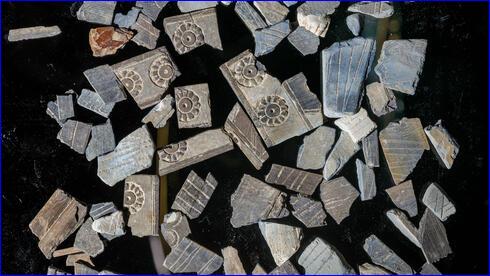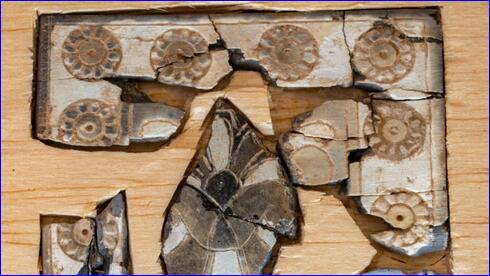


 Eliyahu Yanai)
Eliyahu Yanai)
The plates made of ivory -- considered more precious than gold in the ancient world - were found in the ruins of a large administrative building from 8-7 century B.C. Researches estimate that the plates were used as decoration for wooden furniture, and were used by influential people who occupied the building.
Excavation directors, Prof. Yuval Gadot from Tel Aviv University's Archeology and Ancient Near Eastern Cultures department, and Dr. Yiftah Shalev from the Israel Antiquities Authority, said in a statement that such discoveries were previously made in areas of former kingdoms of Nimrod and Samaria.
They added: "Jerusalem now joins these places for the first time. Jerusalem's importance during that time period was known to us, but these findings emphasize that fact. The plates present another cornerstone in understanding the city's political and economical standing in the ancient world."
The Antiquities Authority said that the impressive building where the ivory plates were found had been burned down, likely during the destruction of the First Temple by the Neo-Babylonians in 586 B.C., causing the ivory to shatter.
During the excavation, 1,500 fragments of ivory pieces were ound. The plates were later reassembled in a specialized process by conservator Orna Cohen, along with Ilan Naor from the Antiquities Authority.
"After combining hundreds of fragments we realized that the collection contains fragments of at least 12 small square plates, that originally decorated wooden furniture," they said.
The ivory plates weren't the only findings in the dig. Inside the building - an agate stamp, amphorae filled with wine spices with vanilla, decorated stone items, and wooden items that were probably part of larger wooden furniture - were also discovered.
The Antiquities Authority said a microscopical analysis done by Harel Shochat from Haifa University, discovered that the ivory originated from an elephant's tusk.

 Gil Mezuman)
Gil Mezuman)
"The ivory's prestige also has much to do with the skill it takes to produce it," Prof. Gadot said. "It's likely that the collection was imported, and was originally produced by artists from Assyria. They could have arrived in Jerusalem as part of a gift sent from Assyria to the Jerusalem noblemen."
The decoration on most of the ivory are uniform, and include a frame inscribed with roses, and a stylized tree at the center. Other plates were decorated with lotus flowers and geometric patterns.
According the Dr. Ido Koch and Reli Avishar from Tel Aviv University, roses and trees were popular symbols in visual decorations in Mesopotamia and other cultural centers. Similar ivory items were discovered in palaces in the center of the Assyrian empire.
The Antiquities Authority said that the adoption of these symbols by the nobility in the northern Kingdom of Israel, occurred when it was under the rule of the Assyrian empire in the second half of the 8th century B.C.
What is even more fascinating is the lack of other motifs - such as animals as animals and gods, which are present on ivory decorations found outside of Jerusalem - on the newly found plates.
"This could mean the Jerusalem nobility decided which symbols to accept, and which to reject."
Culture and Sports Minister Hili Tropper said: "The discovery of ivory in Jerusalem sparks the imagination and connects between the past, present and future of our country.
"The Antiquities Authority, with cooperation with the Culture and Sports Ministry, Jerusalem and Heritage Ministry and academic institutions led the archeological operations that produced impressive findings, and keep surprising us with its successes to locate lost treasures."
Eli Escuzido, head of the Israel Antiquities Authority, said: "Excavations in the City of David are always surprising. This time, through gentle and awe-inspiring work of researchers and conservators, we managed to get a glimpse into the daily lives of people who lived here a thousand years ago.
"These finding bring ancient stones to life. The understanding that the material wealth possessed by Jerusalem elites during the days of the First Temple was equal, and maybe surpassed that of other governing centers in the ancient near east -- points to Jerusalem's status and importance during that time."
The rare findings will be presented on November 13 during a conference of City of David researches, as well as in the Antiquities Authority's convention planned for October.

or register to post a comment.